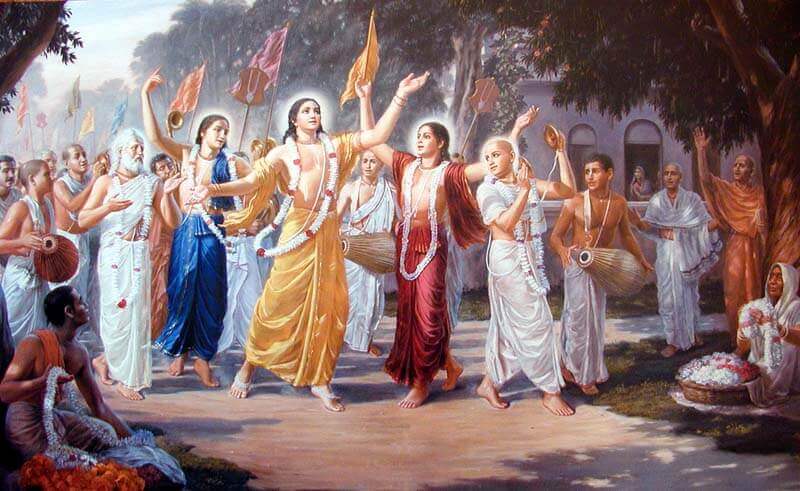Chaitanya Mahaprabhu: Perceiver of Krishna.

Today, is the birthday of Lord Krishna. All over India, Janmashtami is celebrated with high enthusiasm, dancing and chanting of what might be the most recognizable mantra globally
हरे राम हरे राम । राम राम हरे हरे ॥
हरे कृष्ण हरे कृष्ण । कृष्ण कृष्ण हरे हरे ॥
This mantra is commonly associated with Hare Krishna movement pioneered by International Society of Krishna Consciousness (ISKCON). Founded in 1966, in New York city, the ISKCON spiritual society was established by A. C. Bhaktivedanta Swami Prabhupada, on the principles laid by a 15th century scholar Sri Chaitanya Mahaprabhu.
On the full moon night of 18 February 1486, during lunar eclipse, Chaitanya Mahaprabhu was born in Nabadwip, a town near Mayapur. His given name was Vishvambhar Mishra, but locals called him Nimai ( one who is born under Neem tree ). Another common name among the locals is Gaurangdev for his relatively fair complexion. His parents were respected Brahmin. His maternal grandfather was renowned astrologer of his time. There are many stories of his early age intelligence and wittiness. By the age of 5, he was accomplished in Bengali, By age of 14, he was passable scholar in Grammar, Rehotiric, the Smrti and Nyaya(justice) and Sanscrit. He was considered one of the best scholar of Nadia, with unparalleled skills in debate and literary discussions.
He was married to Lakshmi Devi, at the age of 15. Being a married man, He travelled east on the banks of Padma to acquire wealth. His showcased his learnings, earning him patronage of many. He soon became known as undefeated Numai pandit, and was considered one of the best pandit in the region. It was at this time that he preached Vaishnavism at intervals.
Around the age of 17, when his wife passed away due to snake bite, He travelled to Gaya with host of students. There, he took spiritual initiation from Iswar Puri, a Vaishnava sannyasi, and a disciple of the renowned Madhavendra Puri.
At an early age of 24, Chaitanya left his home to become a Sanyasi. He travelled to different places in the country and taught Bhakti yoga. He also visited Vrindavan. This was the period when the country was under Islamic influence, most of the religious places were either destroyed or forgotten. Today’s Vrindavan owes its existence to Chaitanya, who along with his disciples, located many places associated with Shri Krishna including the famous seven temples visited by Vaishnavas in Vrindavan. His disciples, called Goswamis, stayed here to re-establish Vaishnavism. The seven temples established by these Goswamis are-
- Sri Sri Radha Madan Mohan temple
- Sri Sri Radha Damodar temple
- Sri Sri Radha Syamsunder temple
- Sri Sri Radha Ramana temple
- Sri Sri Radha Govinda temple
- Sri Sri Radha Gokulananda temple
- Sri Sri Radha Gopinath temple.
Leaving his students in Vrindavan, he travelled once again, to east. By this time, His fame as a learned scholar had spread to far places. He was invited to Odisha, where he preached vaishnavism, and participated in nayas ( a form of debate tournaments held by kings and patrons ). He stayed in Puri for remaining of his life surrounded by his students. His devotion to Lord Krishna was so strong that nowadays some considers him a reincarnation of Lord Krishna.
Devotees of Krishna today have a great affection to the Mahaprabhu. For them, The Nabadwip and Mayapur, holds as importance as a Dhaam. The Vaishnavas who come here as pilgrims to visit the places connected with the life of Mahaprabhu. Both these places are located on the river banks and boats are the best mode of transport between them. A trip here is an experience in itself. It transports you back in time as you can feel the presence of Mahaprabhu everywhere.
Today, from the foundation of his teachings, ISKCON has more than 600 temples globally, and is the largest Hindu Organization. On top of that, Krishna is most recognizable deity globally. His teachings and principles, has played an important role in modern Hinduism.